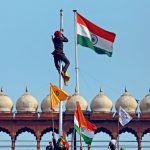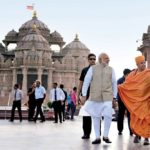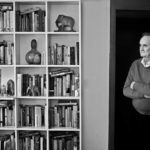The Hindu Inflexion
The domes of Babri Masjid fell on the remains of the Nehruvian consensus. The aftershocks are being felt even today
 Swapan Dasgupta
Swapan Dasgupta
 Swapan Dasgupta
Swapan Dasgupta
 |
30 Nov, 2017
|
30 Nov, 2017
/wp-content/uploads/2017/11/Hinduinflexion1.jpg)
EVEN THE PASSAGE of 25 years hasn’t succeeded in eroding my memory of that day. I even remember the time: 3.45 pm on December 6th, 1992, when the first dome of the contentious shrine crumbled in a cloud of red dust.
That was irrevocable confirmation that what was being witnessed since noon that day was not merely extensive damage to a Mughal shrine, but something far more momentous, perhaps even the total demolition of the Babri Masjid—a mosque that had functioned as a Rama temple since 1949.
The sequence of events leading up to it and the hasty organisation of a makeshift temple on the ‘garba griha’ has been narrated in detail enough elsewhere not to warrant repetition. There are memories of the Rama Shilan pujas that were being held in the run-up to the 1989 General Election, the tumultuous passage of LK Advani’s rath yatra, the drama that preceded a foiled kar seva (‘devotional service’) in October 1990, and the police firing that resulted in so many deaths, the crazy 1991 General Election campaign that was in effect a referendum on Rama and included the fiery sermons of Sadhvi Rithambara and, finally, the kar seva on December 6th whose outcome was both unexpected and historic.
I was fortunate to have a ringside view of the events of December 6th from the terrace of a bhavan on the perimeter of the shrine that also served as the dais for the Vishwa Hindu Parishad and Bharatiya Janata Party leadership assembled in Ayodhya.
No one quite knew how the day would shape up. On the evening of December 4th, I ran into journalist Nikhil Chakravartty, with a reputation for being one of the best informed people in the Capital, at the India International Centre. When I told him that I was proceeding to Ayodhya, he drew me aside and simply said: “The real action is in Delhi.”
It was a tip-off that couldn’t be dismissed lightly. For weeks there had been persistent rumours that the wily Prime Minister PV Narasimha Rao had entered into a covert deal with the BJP that would allow for a symbolic kar seva in Ayodhya but no more. Indeed, when I met Chief Minister Kalyan Singh in Lucknow on December 5th, he more or less indicated to me that nothing dramatic was really expected in Ayodhya the next morning. The BJP had even organised a public meeting somewhere in Lucknow that evening with Atal Bihari Vajpayee as the star speaker. Vajpayee was characteristically eloquent and extremely witty when he described the large crowds in Ayodhya that left people with no room to move. His message was clear: don’t add to the human crush, just stay at home.
No sooner had Vajpayee concluded than the beacon-flashing motorcade of BJP President Murli Manohar Joshi drew up. But curiously, Joshi didn’t complement what Vajpayee had said. Instead, he launched into a spirited espousal of the Rama Janmabhoomi cause, including an appeal to turn up in Ayodhya in large numbers the next morning.
I was travelling with my old friend and journalist, and subsequently Rajya Sabha MP Chandan Mitra. Both of us ended the day a little confused. Which version of the next day should we treat as authentic? Would there be a mere symbolic kar seva that consisted of a few pujas and a symbolic cleaning of an area outside the contentious 2.77 acres? Conversely, would the BJP-VHP manage to control the anger of kar sevaks (devotees) from all over the country? There had been at least national mobilisations of kar sevaks. How long could the movement continue mobilising Rama bhakts without having anything tangible to show?
I think our unstated understanding was that December 6th would see a grand show of strength but nothing beyond that. After all, there was the assurance to the Supreme Court by both the Central and Uttar Pradesh governments that the status quo would not be disturbed by the kar seva.
It was keeping in mind an anticipated anti-climax that we set off from Lucknow at a leisurely pace, to reach a crowded Ayodhya around 10.30 am. It was fortuitous that Chandan parked his Gypsy at a point not terribly far from the improvised stage on the terrace of a single-storied structure. We negotiated our way through a big huddle of Adivasi kar sevaks from Madhya Pradesh, ignoring some of the rude taunts that were hurled when they discovered we were journalists. It was equally fortuitous that we met Deepak Chopra, Advani’s private secretary, who helped us enter building and climb onto the large stage where there was adequate seating space.
It was around noon that the first hint of trouble reached the leadership on the dais. It was reported that a small contingent of kar sevaks had broken ranks and were climbing onto the domes with crowbars and hammers. In hindsight, it has been suggested that the demolition was a grand conspiracy. However, at noon on December 6th when the first news of possible direct action by a section of kar sevaks was received by the BJP leaders present, there was genuine surprise. I recall seeing Advani walking off in a huff and an incensed Rajmata Vijaya Raje Scindia telling some of the VHP functionaries to yank people off the domes by their trousers. Indeed, there were numerous appeals on the public address system asking people to keep the peace and desist from doing their own thing. Someone asked Ashok Singhal, arguably the real head of the Rama Janmabhoomi movement, to go to the site—about 100 metres from the place where the leaders had assembled—and calm things down.
My first indication that events were taking their own course came around 1.30 pm when I asked Pramod Mahajan to assess the likely extent of damage. The good thing about Pramod was his bluntness. “What damage?” he retorted, “There will be nothing left”
I don’t remember what exactly transpired in the next two hours, except everyone getting into an almighty huddle. My first indication that events were taking their own course came around 1.30 pm when I asked Pramod Mahajan to assess the likely extent of damage. The good thing about Pramod was his bluntness. “What damage?” he retorted, “There will be nothing left.”
This was confirmed at 2.30 pm when we spotted a man, his forehead covered in dust and his face smeared in blood, running towards the podium. He was carrying something covered in a dirty cloth with him, and he was accompanied by a few others. He came up to where a glum-faced Advani was sitting and offered this small bundle to him. Advani recoiled in surprise. Wrapped in the dirty piece of cloth was the Ram Lalla murti that had mysteriously appeared in the garba griha in 1949 to formalise the restoration of control of a sacred site that was believed to have been appropriated by invaders—there is still some doubt whether the temple was demolished by Mir Baqi in 1528 or much later during the reign of Aurangzeb.
After that, it was really a wait for the inevitable. After the second dome fell, Sadhvi Rithambara took over. From the podium, she worked up the huge crowd, chanting “Ek dhakka aur doh, Babri Masjid tod doh.” It was both frightening and mesmerising at the same time. The spectacle of a teeming crowd swaying to her chant is a memory that will always remain with me.
At around 4.45 pm, to ecstatic shouting that must have been heard even in neighbouring Faizabad, the entire disputed shrine crumbled to dust. On the terrace, sullenness gave way to ecstatic celebration as leaders and activists hugged each other. Some of the women were in tears and KS Sudarshan, later to become RSS sarsanghchalak, drew me aside and said: “History doesn’t always happen; sometimes it is made to happen.” In the distance I could see black smoke billowing. “There will be riots,” Mahajan remarked, his countenance reflecting deep concern.
The only person who struck a different note was Advani, the leader who had been offered the Ram Lalla idol because he was seen to epitomise this historic movement. He didn’t come up on the terrace but sat alone in a dark room, with just a candle by way of light. He was distraught, not least because this was not the course he envisaged for the movement that had helped redefine the contours of Indian politics.
THERE WERE TWO distinct phases of the Ayodhya movement: pre-demolition and post-demolition.
I recall seeing LK Advani walking off in a huff and an incensed Vijaya Raje Scindia telling some of the VHP functionaries to yank people off the domes by their trousers
The first phase lay in taking an important, but yet localised, dispute in Awadh that dated back to at least the 17th century and transforming it into a symbol of a larger battle to rekindle Hindu consciousness and even give it a political direction. This phase was marked by spirited attempts after 1989 to persuade Hindus that Ayodhya was more than just a battle to reclaim an important Hindu shrine that had been taken away from the community by invaders—both Mughal and British. It was presented as a symbol of incomplete independence and evidence of a spurious secularism that had ended up denying Hindus their rightful inheritance.
The first phase was marked by doughty secularist resistance and fierce Muslim opposition to the Rama Janmabhoomi movement. Historians were mobilised to contest the claim that the ruins of a grand temple lay under the foundations of the Babri Masjid. The entire intellectual galaxy of India, which was beholden to a Congress system that had nurtured and patronised them since 1947, was drawn into the public sphere to oppose the saffron interlopers. Denial of the proposed temple and strategies to maintain the status quo in perpetuity were evolved, not least as an electoral strategy. Vishwanath Pratap Singh, the man who became Prime Minister on the crest of a growing anger against corruption, even devised a crafty strategy to divide Hindus on the basis of caste, a move that was calculated to puncture any grandiose notions of Hindu solidarity.
The demolition of December 6th, 1992, resulted in widespread civil unrest in India. There were vicious riots in Mumbai, culminating in the serial blasts of March 1993 that could be said to have begun a new chapter of Muslim resistance. However, the Hindu revolution that the likes of Ashok Singhal believed would be triggered by the demolition proved far more elusive. The BJP was able to consolidate the gains it made after the 1991 General Election, but the all-round gang up of secular forces that followed the demolition saw Vajpayee’s first shy at national power truncated to a mere 13 days.
In the immediate aftermath of the demolition and the riots that followed in its wake, the BJP was indeed cast as a political pariah. But this proved remarkably short lived for a number of reasons.
First, Narasimha Rao calculated that the old Nehruvian order had run its course and that India needed to be governed by a new set of assumptions. The liberalisation of the economy that was begun with Manmohan Singh’s 1991 Budget was not triggered by the Ayodhya movement, but it was definitely also aimed at undercutting the BJP’s gains. It was felt that the shift of focus from identity politics to economic self-interest would redefine the contours of the mobilisation. In theory, this seemed a correct assumption, but the reality turned out to be very different. The Congress failed to internalise the larger message of economic liberalisation and saw it as providing greater opportunities for corruption. This, coupled with the chaos that followed under the two United Front governments between 1996 and 1998, plus the comforting leadership of Vajpayee allowed the BJP to break out of its isolation. To Hindu pride was added ethical politics and stability—a powerful combination that allowed the BJP to tie up with regional parties and govern India from 1998 to 2004.
Secondly, the mobilisation around Ayodhya resulted in the creation of a Hindu vote bank that could appeal to at least 25 per cent of the electorate, a large enough share for India’s regional parties to see benefits in an alliance with it. There was a psychological fallout as well. Prior to 1992, secularism in India was marked by a generous measure of asymmetry. As S Gopal, Nehru’s official biographer described it, ‘the problem of minorities was basically one for the majority community to handle. The test of success was not what the Hindus thought but how the Muslims and other communities felt.’ This secular ‘common sense’ also marked Manmohan Singh’s December 2006 speech to chief ministers that “minorities, particularly the Muslim minority… must have the first claim on resources.”
After the second dome fell, Sadhvi Rithambara took over. From the podium, she worked up the crowd, chanting “Ek dhakka aur doh, Babri Masjid tod doh.” It was both frightening and mesmerising
After 1992, it became increasingly difficult for ‘secular’ parties to persevere with such assumptions. Although the shifts were slow and halting, Ayodhya facilitated a recognition that specifically Hindu interests could no longer be brushed aside dismissively. Simultaneously, there was a parallel acknowledgement that pandering to narrow sectarian impulses such as the enactment of the Muslim Women’s Bill after the Shah Bano judgment would invariably generate a countervailing reaction.
Initially, fed by some rather contrived and somewhat wishful quasi-academic assessments of the Rama temple movement, there was a belief that the Mandal Commission recommendations had negated the influence of any Hindutva among Backward Castes. It was believed that the Rama temple agitation had, at best, consolidated the BJP’s support among the upper castes and the trading communities who were in any case inclined towards the party. In a curious article in The Times of India, for example, the Marxist- inclined academic-journalist Arvind Narain Das detected a method behind the choice of Rama as the icon. A Kshatriya, he argued, was deliberately preferred over other possible choices: the Krishna Janamstan in Mathura and the Gyanvapi Masjid, built after the destruction of the old Kashi Vishwanath Temple in Varanasi. Lord Krishna was a Yadav and Lord Shiva’s origins were tribal.
THIS THEORY GOT a hard knock during the Uttar Pradesh Assembly election of 1991 that was held simultaneously with that year’s General Election. All the data suggested that the BJP owed its victory considerably to a very large chunk of OBC support. Anecdotal evidence suggested that a vast measure of rural support also came from women who may have been driven by religiosity. Other anecdotal evidence suggested that various Adivasi communities in Madhya Pradesh and South Bihar (now Jharkhand) also swung to the BJP as a result of the Rama temple movement. Overall, the agitation helped the BJP gain a wider social foothold, although it would be some time before a larger geographical spread was achieved. In states such as Gujarat and Rajasthan, the BJP also edged out other non-Congress parties to emerge as the principal challenger to the Congress.
Finally, the opposition to the Rama temple had often rested on some dodgy assertions by Left historians, many of whom teamed up with the Babri Masjid Action Committee to play ‘experts’. The intellectual hold of these historians who steadfastly denied there was ever a temple on the site of the Babri Masjid was quite profound, and they got huge play in the English-language media. Bodies such as the Indian History Congress were also brought to bear in attempts to rubbish all claims of the temple’s historical authenticity.
These scholars received a big jolt when the judgment of the Allahabad High Court in September 2010 not only accepted the contention—based on both archaeology and historical documents— that a temple predated the Babri Masjid on that site, but it cast aspersions on the claims of many ‘eminent’ historians to domain expertise. Indeed, once the depositions of many of the pro-Babri historians, including those with formidable reputations in institutions such as Jawaharlal Nehru University, became public, they suffered a serious loss of face. It is interesting that since 2010, historians have largely kept their silence.
The other consequence of the 2010 Allahabad judgment is that the secularist belief that the courts would inevitably rule against the temple has suffered a grievous setback. It would be fair to say that after the 2014 General Election and the 2017 Uttar Pradesh election, the quantum of opposition to a proposed temple has diminished quite substantially. While the belief that any new Rama temple on the disputed site in Ayodhya would be an outrage on India’s secularism still persists in intellectual circles, the political class as a whole seems less hostile. Indeed, there is now a grudging realisation that opposing the temple in the same way as pre-1992 would carry a great electoral risk. There is still a lingering hope that judicial procrastination would dissipate the energies of those anxious to see a temple built on the site, but there is also a simultaneous acknowledgment of the inevitability of a temple on the disputed site in Ayodhya.
The last word on the Ayodhya dispute has not yet been written. When the matter does get resolved, if it ever does, historians and scholars will attach considerable significance to the larger fallout of the demolition of the Babri shrine 25 years ago. Coinciding as it did with the death throes of the Nehruvian consensus and the initiation of a new direction for the economy, the Ayodhya movement had unintended but profound consequences. December 6th, 1992 was an inflexion point for modern India.
About The Author
CURRENT ISSUE
Rashmika Mandanna: India’s Sweetheart
MOst Popular
4

/wp-content/uploads/2025/04/Cover-Rashmika-New.jpg)













More Columns
Saving Farmers from the Unions Siddharth Singh
The New Hotspot Kaveree Bamzai
Chills and Spills in Small Town America Kaveree Bamzai